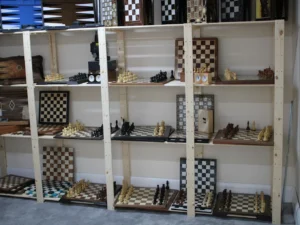
The King In a Game of Chess

The King is the most valuable chess piece in the game. The purpose of the entire game of chess is to protect the King at all costs. As we will go on to discuss, the movement of the King is pretty insignificant and is usually only needed when placed under a check.
- The position of the King
- How does the King move?
- How does the King eliminate?
- What is a check position?
- How to get out of a check?
- Castling
- What is a checkmate position?
- What is a Stalemate position?
The Position of the King

An easy way to remember this is that the Kings will always face each other. Furthermore, it is very important to know that the King is the only piece that must be protected. If a King is under attack, this is usually termed ‘Check’.
The Rook, Knight and Bishop positioned F1, G1 and H1 respectively, are all Kingside pieces. Vice versa, the pieces positioned A1, B1 and C1 are all termed Queenside chess pieces.
How does the King move?
Contrary to what we might think, the King is much less influential in it’s movement compared to majority of its neighbouring chessmen. The movement is in fact, very limited and therefore the movement of other pieces around the King is much more significant. This significance relates to barricading the King from the opponent, or attacking an opposition piece and diverting their attention away from the King.

As seen here, the King can move forwards, backwards and in diagonals in any direction but only by a single step. It is also important to note that the King can never move into a ‘check’.
How does the King Eliminate?
The King eliminates an opposition piece by capturing and taking its position. However, it isn’t a long range piece and any piece that is in close proximity will place the king in ‘check’ aside from the knight, a bad bishop or a pawn that is positioned straight ahead. The knight may only travel in an ‘L’ shape so it cannot attack the king from the position it is in below. The bishop is known as a ‘bad bishop’ as it is on the opposing coloured square, and as it can only travel in diagonals, this renders it useless for attack unless the king was to move to a darker square. The pawn cannot move backwards hence, it is also unable to attack.

The King can easily eliminate the chess pieces surrounding it but none of these pieces pose a threat to the king in this case. Likewise, the black Rook in the position E2 would not be able to leave the King in check either. However, if this Rook was to move from E2 to F2, it leaves the King in a ‘check’.
What is a Check Position?
A check position is when your King is under attack from an opposition piece. Now, what does this statement actually mean in terms of play? It means that the next move can result in your King being eliminated and therefore, either the King needs to be moved into safety, or a different piece must block this check. If the wrong move is carried out, this results in the opponent winning the game.
How to get out of a Check Position?
The king can simply move out of a check position as long as the landing square will not put the king in danger. This could be behind another piece or onto a square where the attacking piece can no longer attack.


The black Rook is likely to place the King under further pressure depending on it’s next move.
In certain situations, the King may be able to eliminate the opposition attacking piece. However, this is where you must be assertive and careful with your move. It may be that your opponent is either trying to set up a trap or the piece trying to attack you is not within range. As seen in the example below, the Rook is placed in the position E1 which allows the King to very easily eliminate the threat.

Barricade the Check. This very simply means, moving one of your chess pieces to block this check, at this position you would be willing to sacrifice any piece to ensure your King is protected. Seen in the example below, the black Rook positioned C2 leaves your King in check, protecting your King is vital and therefore you can move your Rook from E3 to E2.


We now have knowledge that protecting the King at all costs is very important. The King is a piece you are simply unable to lose and therefore all measures must be considered and taken when necessary.
Castling
Castling is an extremely efficient move that involves the King and the Rook. The Rook positioned on the side of the King is effectively called the ‘Kingside’ Rook and likewise the same for the Queen side Rook being called the ‘Queens Side’ Rook. This move allows both the King and Rook to make two separate moves just in one.


Castling allows for the rook to be positioned more centrally and was designed to speed up the game. In turn this allows the King to be further protected. There are a couple of stipulations in place in order to conduct this move.
Firstly, there should be no other chessmen in-between the respective Rooks and the King, Secondly, the Rooks and the King are still in their initial position in order for the move to be conducted. Lastly, the King cannot move out of check with this move or move into a check whilst the move is conducted.
Now the ideal benefit of castling allows your Rook to be in a position closer to the centre of the board, inline with other potential threats. Meanwhile, the King would be safe and sound in the corner behind yet another powerful piece.
What is a Checkmate Position?
Checkmate is when there is no way out for the King piece, i.e., any move that the King will leave it in a position for elimination. This is essentially the endpoint of the game.
What is a Stalemate Position?
A stalemate is very much an agreement between both chess players where it is impossible to place either King into a checkmate position.





